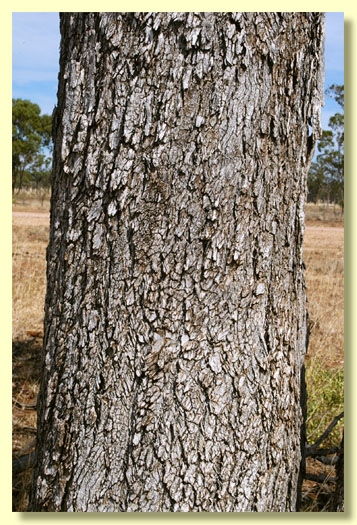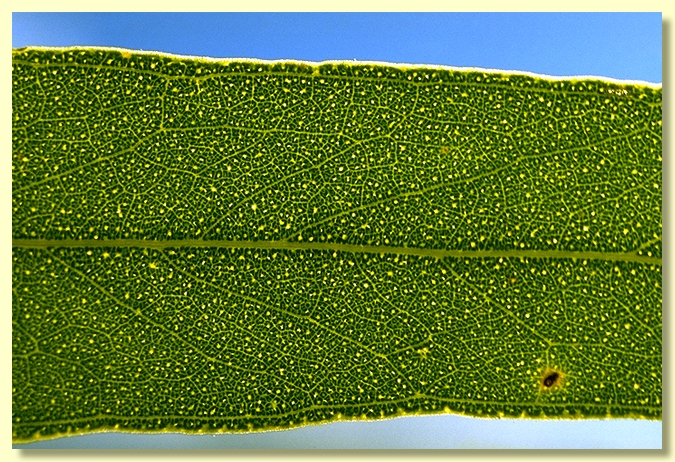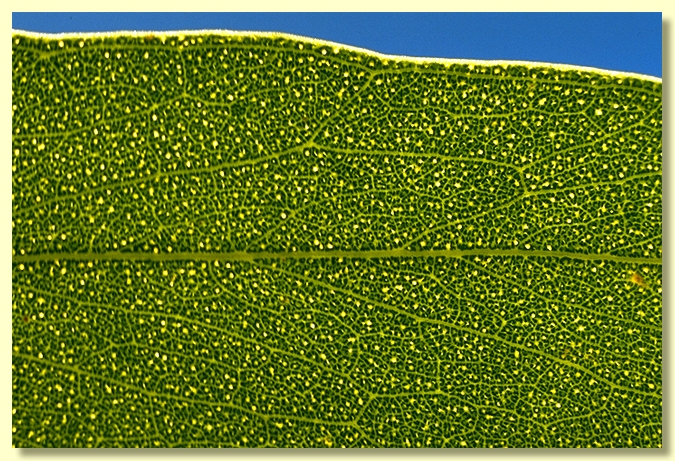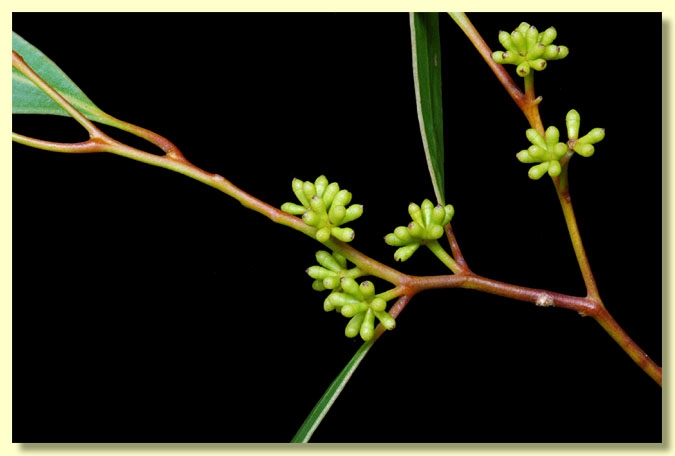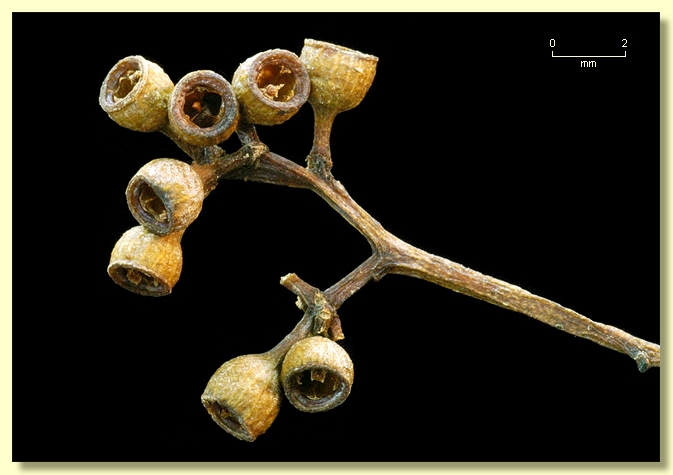Euclid - Online edition
Eucalyptus brownii
Eucalyptus | Symphyomyrtus | Adnataria | Apicales | Buxeales | Amissae
Eucalyptus brownii Maiden & Cambage, J. & Proc. Roy. Soc. New South Wales 47: 215 (1913).
T: Queensland: Reid River, via Townsville, N. Daley 8, December 1912. Lectotype: NSW303042; isolecto BM (specimen on left-hand side), BRI AQ09642, NSW303043); fide Bean, A.R., Telopea 12(4): 470 (2010).
E. bicolor var. parviflora F.Muell. ex Benth., Fl. Austral. 3: 215 (1867). T: Queensland: Burdekin River, 1857, F.Mueller; holo: K; iso: NSW.
Tree to ca 18 m, sometimes spreading with pendulous branches. Forming a lignotuber.
Bark rough to the small branches, hard, fissured, box-type, grey-brown to bleached grey.
Branchlets lack oil glands in the pith.
Juvenile growth (coppice or field seedlings to 50 cm): stems rounded in cross-section; juvenile leaves always petiolate, alternate, ovate to broadly lanceolate but lower leaves may be ± elliptical, 4–9 cm long, 1.4–3.2 cm wide, green to grey-green.
Adult leaves alternate, petioles (1)1.5–3(3.5) cm long; blade lanceolate to broadly lanceolate or rarely falcate, 6–17 cm long, 1–3.6 cm wide, base tapering to petiole, margin entire, apex pointed, concolorous, glossy, green, side-veins at an acute angle to the midrib, sometimes almost parallel with the midrib, reticulation dense to very dense, intramarginal vein present but close to edge, oil glands intersectional.
Inflorescence terminal compound or axillary single umbels, peduncles slender, 0.3–0.8 cm long, buds 11 to 15 per umbel, rarely with more than 15 buds, pedicels 0.1–0.4 cm long. Mature buds obovoid, 0.2–0.4 cm long, 0.2–0.3 cm wide, scar present (outer operculum shed early), operculum rounded, stamens irregularly flexed, all fertile, anthers adnate, basifixed, globoid, dehiscing by lateral slits, style short or long and straight, stigma blunt or tapered, locules 4, the placentae each with 4 vertical ovule rows. Flowers white.
Fruit pedicellate (pedicels 0.1–0.3 cm long), usually cupular to sometimes campanulate, 0.2–0.3 cm long, 0.2–0.3 cm wide, disc descending obliquely to vertically, valves 4, enclosed or just below rim level.
Seeds dark brown, 1–1.3 mm long, flattened-ovoid, dorsal surface shallowly reticulate, hilum ventral.
Cultivated seedlings (measured at ca node 10): cotyledons small, reniform; stems square in cross-section; leaves shortly petiolate, opposite for 4 to 8 nodes then becoming alternate, lanceolate to broad lanceolate to ovate, 5.5–13.5 cm long, 1–4.2 cm long, base tapering, green.
Flowering has been recorded in January, May, August, September and October.
A small to medium-sized tree endemic to central-eastern Queensland from the Connors River area south of Sarina, south-westwards through the Clermont region as far as Barcaldine and then north to the Hughenden area and further east through Charters Towers to just south of Townsville. North from Hughenden it extends further to just south of Mt Garnet. Eucalyptus brownii is characterized by having persistent box bark to the small branches, relatively narrow glossy adult leaves, small obovoid buds with rounded opercula and small cupular fruit to 0.3 cm wide and long.
Eucalyptus brownii belongs to Eucalyptus subgenus Symphyomyrtus section Adnataria (the boxes) because the buds have two opercula, ovules are in four rows, seeds are flattened-ovoid, cotyledons are more or less reniform and anthers are rigid on the staminal filaments. Within section Adnataria, E. Brownii is part of a subgroup, series Buxeales. This is a large group of species further distinguished by having terminal inflorescences and buds that lose the outer operculum early. Within series Buxales E. Brownii is most closely related to E. Populnea (found in New South Wales and Queensland), E. Cambageana (a Queensland endemic), E. behriana (found in Victoria and southern New South Wales), and E. Sparsa (found in Central Australia; all have very glossy crown leaves, and in bud have stamens irregularly flexed and all fertile.
Eucalyptus brownii is closest to E. Populnea, both box species possessing very glossy adult leaves and small fruit and are completely rough-barked. E. Brownii differs by normally having narrow lanceolate adult leaves (normally orbicular to broadly ovate in E. Populnea). However in areas of central Queensland where the northern limit of E. Populnea meets the southern limit of E. Brownii, trees with intermediate leaf morphology are very common, and it will be not possible to assign these to either species name. Eucalyptus cambageana has broader adult leaves than E. Brownii and is rough-barked only on the trunk, the branches being conspicuously smooth white.
To its north is another box species with very glossy adult leaves, i.e. E. Chlorophylla. E. Chlorophylla differs by having buds with an acute operculum (round in E. Brownii) and larger fruit (0.3–0.6 cm wide in E. Chlorophylla and 0.2–0.3 cm wide for E. Brownii).
Eucalyptus brownii: after Robert Brown (1773–1858). Robert Brown was one of the great botanists of his time and made a significant contribution to botany of the early days in the Australian Flora. He accompanied Matthew Flinders as the naturalist on the ship the Investigator which, in 1801 to 1804, explored the coastline of Australia, where Brown collected over 2000 species new to science. He remained in Australia for a short period after this, collecting in Tasmania and along the central coast of New South Wales before returning to London in 1805, where he then worked for many years on his vast collection from Australia.


